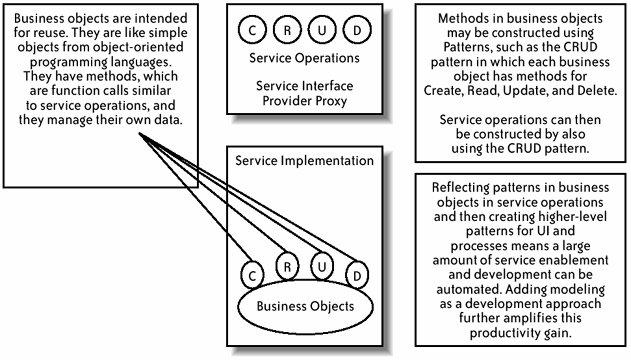Section 5.4. The business objects layer
5.4. The business objects layerIf enterprise services are interfaces to reusable functionality for the automation of processes, process steps, parts of process steps, and utilities, business objects are the reusable units of functionality that exist within service providers to help implement enterprise services. As mentioned so far, the business objects layer exists in service providers and enterprise applications to represent business entities. The newest generation of business objects was constructed with support of enterprise services in mind. So far, this is not a large group of applications. But as time passes and the mySAP Business Suite is enhanced over the next few years, more services will be automatically created from business objects. Business objects are important for everyone in the SAP universe for two reasons. First, as services are built on top of the mySAP Business Suite, they will be created through a process of modeling. Process components will define groups of processes that are connected. Inside process components, processes will be modeled by describing through a modeling language how the processes will be automated in terms of enterprise services. The structure of enterprise services will then be described in terms of how business objects implement them. Even when the right business object does not exist to support an enterprise service in the next few versions of the Enterprise Services Repository, notional business objectsthat is, business objects that exist only in the modelwill be created in the Enterprise Services Repository to show how business objects would implement the enterprise services if they existed. In this way, business objects of the future will exist as notional objects in the Enterprise Services Repository alongside real ones to start showing developers inside and outside of SAP the future structure of the service providers that will use business objects to implement enterprise services. The other reason business objects are important is that they are in use inside of composite applications, which have their own needs to create reusable units of functionality. Later discussions of composite applications in this book will show how business objects play various roles in composite applications: as a container for new functionality in a composite; as a way to combine existing services into a more useful form for use in a composite; or as a way to support the implementation of services that will be offered by the composite, for example. So, what is a business object? It is beyond the scope of this book to explain every detail of how business objects that have been used in the past will work in the future, but we can provide a high-level preview in the following list and summarized in Figure 5-9:
Figure 5-9. Business objects and enterprise services Business objects represent a standardized structure that accelerates the implementation of enterprise applications, service providers, and composite applications. Business objects make it much easier to create and maintain the hundreds of thousands of enterprise services that will be needed in the future. |
EAN: 2147483647
Pages: 265